
Учебное пособие 2006
.pdf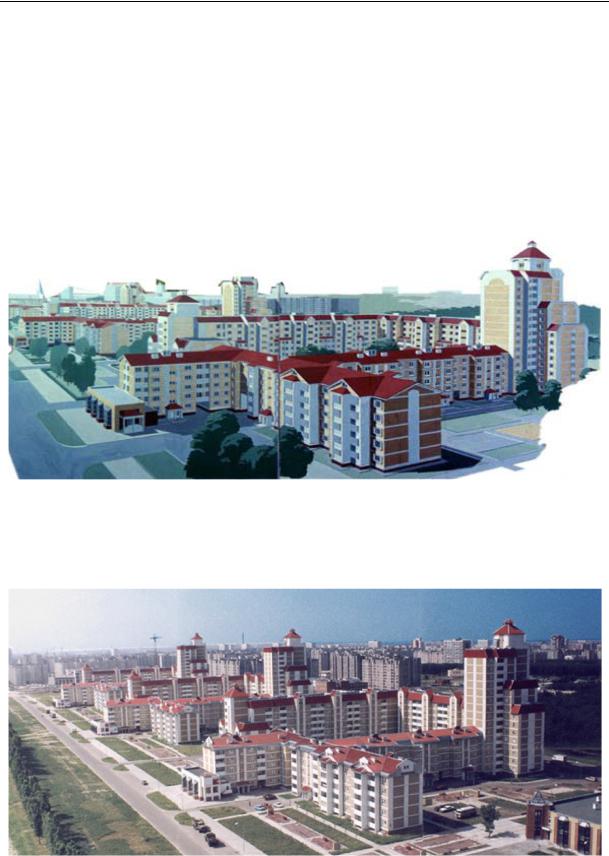
Russian Journal of Building Construction and Architecture
and 15th floors have a larger number of apartments on each floor since the steps are formed by part of the sections located meridionally. Three groups of residential buildings, consisting of five-, eightand fifteen-storey block sections, make for a rhythmic row along Moscow Avenue, echoing the scale of the city's central quarters. Turning the avenue, one sees the building from afar, at the entrance to Voronezh from the north. Pitched roofs, a number of architectural details, a bright color scheme lend the building a unique, memorable image, which has become familiar to the locals and visitors alike (Fig. 3, Fig. 4).
Fig. 3. Voronezh City development project in the North. Authors of the project: S. A. Gilev,
S. M. Sorokin, A. K. Zabnin, P. V. Mikhin (engineer) in collaboration with the company "Khopro" ("Berlin"). The color solution is presented by LLC PTM № 3 SA
Fig. 4. Development of the "City of Voronezh" in the North. Authors of the project: S. A. Gilev, S. M. Sorokin, A. K. Zabnin, P. V. Mikhin (engineer) in collaboration with the company "Khopro" ("Berlin").
Photo: A. K. Zabnin
90
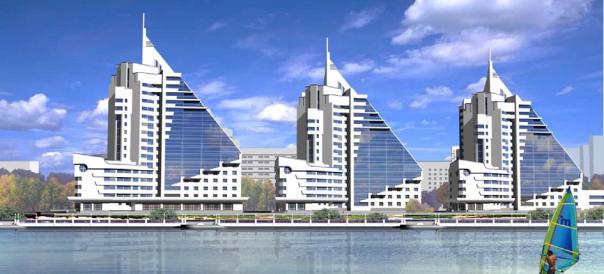
Issue № 2 (50), 2021 |
ISSN 2542-0526 |
The construction of the Morskaya residential complex on the embankment of the water reservoir, which was designed to mark the 300th anniversary of the Russian Navy, is associated with three sailing ships, as if sailing into the open sea. The composition of each "ship" is formed by four block sections of different storeys. The major role in the complex structural organization of the building is played by the shamrock section where three ordinary sections are blocked. The five-storey block section with a sharp end ends depicts the bow of the ship, the branch of the shamrock and the ordinary section with ledges from 5 to 17 floors form a "sail" with a slope of almost 60°, another ordinary block section develops the depth of the site. The complex is distinct from the remote corners of the reservoir, the promenade and the curb of the right bank. Not all design plans were implemented, the finishing materials laid down by the project were not used in the built complex, and many other things never got to see the light of the day (Fig. 5).
Fig. 5. Construction project of the Morskaya residential complex in Voronezh. Author of the project: S. A. Gilev. Co-author: A. K. Zabnin. The project was developed by PTM № 3 SA LLC
Similar shamrock sections and two types of T-shaped block sections are employed in a residential complex on the corner of Shishkova and Begovaya streets. Ordinary block sections of the "sector" type also look quite extraordinary. All the blocks of the complex have differrent storeys (from 5 to 17 floors) and layout techniques. But due to a low quality of construction, a large number of different types of sections and locking techniques developed and applied in the complex did not impact the entire aesthetic appearance of the complex [16] (Fig. 6, Fig. 7).
91
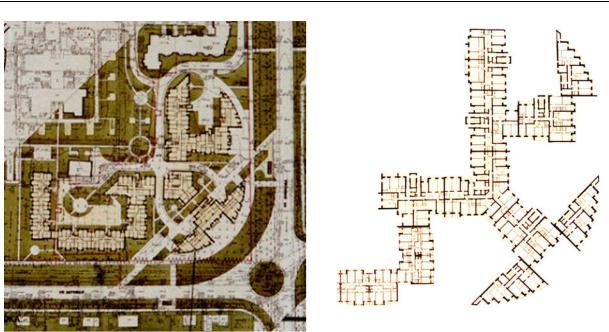
Russian Journal of Building Construction and Architecture
Fig. 6. The scheme of the general plan of the residential |
Fig. 7. Plan of 2-5 floors of a residential |
complex located at the intersection of Shishkov streets |
complex located at the intersection of Shishkova |
and Begovaya in Voronezh. Author: S. A. Gilev. |
and Begovaya streets in Voronezh. Author: |
The project was developed by PTM № 3 SA LLC |
S. A. Gilev. The project was developed |
|
by PTM № 3 SA LLC |
A fascinating example of the layout of "point" volumes of residential buildings is located on Friedrich Engels Street in Voronezh. Five blocks of different heights form a complex symmetrical composition enhancing this part of the street. This object is designed in monolithic structures (frameless frame with a wide pitch of columns and stiffening cores in each block). The modern constructive scheme of the complex allowed two underground floors of car parking to be constructed, and in the first and partially second floors there were rooms of cultural and daily function. The external architectural and artistic appearance of the residential complex, which completes the formation of the historic quarter, looks extraordinary. The symmetrical compositional solution of the complex complements the historic buildings, without interfering with the scale of Revolution Avenue (Bolshaya Dvoryanskaya), the city’s main street (Fig. 8).
A similar constructive scheme of the residential complex "Park Gorky" is implemented on the site of the right bank near the North Bridge of Voronezh. In each of the four blocks of the complex on standard floors there are eight apartments, which are provided with regulatory insulation due to the use of the original locking element in the connection of individual buildings. At the competition "Construction Olympus 2019" held in Voronezh, this object was recognized as the best implemented housing project. However, the buildings of the complex in the
92

Issue № 2 (50), 2021 |
ISSN 2542-0526 |
implemented version differ from the original project: the number of storeys of the blocks was considerably increased, architectural details were eliminated, and the color scheme changed. That impacted the architectural and artistic appearance of the residential complex (Fig. 9).
Fig. 8.Residential complex on Friedrich Engels Street, Voronezh.
Authors of the project: S. A. Gilev, A. V. Bozhko. Photo: L. N. Gileva
Fig. 9. Gorky Park residential complex project. Authors: S. A. Gilev, A. V. Bozhko. Photo: S. A. Gilev
93

Russian Journal of Building Construction and Architecture
Following a considerable relaxing of regulatory requirements for insulation of apartments, it become possible in Voronezh for the first time to apply a block section of a complex cruciform configuration. The monolithic residential house, consisting of cruciform block sections, is located at the bend of the branched structure of the streets which is typical of the preclassical layout of the right-bank slopes of Voronezh, and forms the bridgehead area of the Chernavsky bridge. The building consists of four block sections crashing into the foot of the slope. In the first, second and partially third floors there are rooms for cultural and daily functions, in the basement there is a car parking. However, other public premises on the slope side are also located underground since the building lies on a significant difference in relief. The extraordinary, dismembered shape of the building, the ledges, the pitched roof and the presence of architectural details enabled it to fit into the picturesque right-bank slopes in agreement with the small-scale surrounding buildings. Note that the common use of cruciform block sections is capable of enhancing the modern residential development and vacate some yard space since the "running density" of cruciform sections is a lot higher than that of regular ordinary block sections (Fig. 10).
Fig. 10. Project of a residential complex with built-in non-residential premises and underground parking in Korolev Street (Petrovskaya Embankment) and Detskiy Lane in Voronezh.
Authors: S. A. Gilev, A. S. Gilev, V. V. Kislyansky. The project was developed by PTM № 3 SA LLC
94
Issue № 2 (50), 2021 |
ISSN 2542-0526 |
Conclusions. The examples of construction of a few residential complexes presented in the article are indicative of the significance of using block sections of complex configuration in the formation of a kind of architectural image of mass construction. A thorough analysis of the techniques of layout of residential buildings, differing in shape, configuration and number of storeys of the block section would diversify the development of the city as well as reveal the great potential of the design method set forth by the authors. Despite the limited funding possibilities of mass construction, the designers of residential complexes have been able to achieve architectural originality thereby enhancing the development of Voronezh. Thus, the design technique based on the use of block sections of complex configuration would help urban planners to implement complex challenges facing the urban reconstruction.
The currently corrdinated new master plan of Voronezh, which was prepared by Moscow city planners envisages active construction in the city’s centre. I.e., mass construction is going to have a considerable impact on the city’s entire figurative characteristics. Voronezh residents are fond of the historic center, its classical ensembles, cozy streets, the houses rich in architectural details, the scale of construction. Under the circumstance doing no damage to the architectural environment of the city is the major challenge facing designers and builders. It is the use of block sections of complex configuration and reduction of the average number of storeys compared to the number of storeys used in modern construction of new areas that would help designers to avoid making serious urban planning mistakes in the construction of residential complexes in the vicinity to the city center and to make the new building original and not inferior in its architectural quality to the historic quarters.
References
1.Barkhin M. G., Ikonnikov A. V., Mats I. L., Orlov G. M., Stupin V. I, Yaralov Yu. S. Mastera sovetskoi arkhitektury ob arkhitekture: v 2 t. [Masters of Soviet architecture about architecture]. Moscow, Iskusstvo Publ., 1975 – vol. 1-2.
2.Barkhin M. G. Arkhitektura i chelovek. Problemy gradostroitel'stva budushchego [Architecture and man. Problems of urban planning of the future]. Moscow, Nauka Publ., 1979. 234 p.
3.Vil'ner M. Ya. Ob innovatsionnoi sostavlyayushchei gradostroitel'stva [About the innovative component of urban planning]. Gradostroitel'stvo, 2012, no. 2 (18), pp. 24––27.
4.Glazychev V. L., Egorov M. M., Il'ina T. V. Gorodskaya sreda. Tekhnologiya razvitiya: Nastol'naya kniga
[Urban environment. Development technology: Desktop book]. Available at: http://www. Glazychev.ru/books/gorodskaya_sreda/gorodskaya_sreda.htm.
5.Glazychev V. L. Urbanistika [Urban Studies]. Moscow, Evropa Publ., 2008. 220 p.
6.Gutnov A. E., Baburov A. V., Lezhava I. G. Novyi element rasseleniya: na puti k novomu gorodu [A new element of settlement: on the way to a new city]. Moscow, Stroiizdat Publ., 1966. 127 p.
95

Russian Journal of Building Construction and Architecture
7.Gutnov A. E., Glazychev V. L. Mir arkhitektury: Litso goroda [The world of architecture: The Face of the City]. Moscow, Molodaya gvardiya Publ., 1990. 358 p.
8.Gutnov A. E. Evolyutsiya gradostroitel'stva [The evolution of urban planning]. Moscow, Stroiizdat Publ., 1984. 256 p.
9.Enin, A. E., Chesnokov G. A., Sergeev I. M. Istoriko-kul'turnyi potentsial TsChER i problemy ego sokhraneniya [Historical and cultural potential of the CHR and problems of its preservation]. Voronezh, FGBOU VO «Voronezhskii gosudarstvennyi tekhnicheskii universitet», 1991.
10.Esaulov G. V. Epokhi v zerkale arkhitektury. K stoletiyu A. G. Rochegova [Epochs in the mirror of architecture. To the centenary of A. G. Roch'egov]. Arkhitektura i stroitel'stvo, 2017, no. 1. 160 p.
11.Esaulov G. V. Gradostroitel'naya doktrina Rossiiskoi Federatsii: v poiskakh osnovanii [Urban Planning Doctrine of the Russian Federation: in Search of Grounds]. Gradostroitel'stvo, 2012, no. 2 (18), pp. 8––13.
12.Ikonnikov A. V Arkhitektura goroda. Esteticheskie problemy kompozitsii [Architecture of the city. Aesthetic problems of composition]. Moscow, Stroiizdat Publ., 1972. 220 p.
13.Ikonnikov A. V. Funktsiya, forma, obraz v arkhitekture [Function, form, image in architecture]. Moscow, Stroiizdat Publ., 1986. 288 p.
14.Karmazin Yu. I. Tvorcheskii metod arkhitektora [The creative method of the architect]. Voronezh, Izd-vo VGU, 2005. 496 p.
15.Korbyuz'e L. A. Arkhitektura XX veka: perevod V. N. Zaitseva [Architecture of the XX century]. Moscow, Progress Publ., 1977. 291 p.
16.Kuz'min A. V. Arkhitektura, gradostroitel'stvo, stroitel'stvo –– vyzovy sovremennosti [Architecture, urban planning, construction-challenges of our time], 2018. Available at: https://ardexpert.ru/article/12699.
17.Lazareva I. V. Formirovanie nauchnogo napravleniya «Territorial'nye osnovy gradostroitel'stva» [For-
mation of the scientific direction "Territorial foundations of urban planning"]. Gradostroitel'stvo, 2012, no. 2 (18), pp. 28––32.
18.Posokhin M. V. Gorod dlya cheloveka [City for a person]. Moscow, Progress Publ., 1980. 219 p.
19.Sdobnov Yu. A., Lyubovnyi V. Ya. Goroda Rossii: tendentsii, problemy. Vozmozhnye puti razvitiya i sovershenstvovaniya upravleniya [Russian cities: trends, problems. Possible ways to develop and improve management]. Gradostroitel'stvo, 2012, pp. 14––16.
20.Finogenov A. V. Kak reshit' klyuchevye problemy gradostroitel'stva? [How to solve the key problems of urban planning?]. Zvezda. Available at: https://zvzda.ru/columns/3f88388b65a2
21.Vason E. N. Design jf cities. New York, MIT Press, 1968.
22.Corbusier L. A. New spirit in architecture. New York, Whitney Library of Design, 1975.
23.Francis D. K., Jarzombek M. M., Vikramaditya Prakash. A Global History of Architecture. Hoboken, N.J., John Wiley & Sons, 2007. 816 p.
24.Holl S., Pallasmaa J., Perez-Gomez A. Questions of Perception: Phenomenology of Architecture. San Francisco, 2006. 155 p.
25.Perez-Gomez A. Architecture and the Crisis of Modern Science. Cambridge, Mass.: MIT Press, 2016. 400 p.
26.Perez-Gomez A. The Space of Architecture: Meaning as Presence and Representation. Questions of Perception. Phenomenology of Architecture. San Francisco, William Stout Publishers, 2006, pp. 7––26.
27.Venturi R., Scott-Brown D., Isemour S. Learning from Las-Vegas. Cambridge, Mass., MIT Press, 2018.
96

Issue № 2 (50), 2021 |
ISSN 2542-0526 |
CITY PLANNING,PLANNING OF VILLAGE SETTLEMENTS
DOI 10.36622/VSTU.2021.50.2.008
UDC 7.021:747.012
L. V. Podol'skaya 1
FEATURES AND PROSPECTS OF USING DIGITAL DESIGN OF INTERIORS USING THE EXAMPLE OF FORMING A PRIVATE SPACE
Architectural Bureau DE-CITY 1
Russia, Moscow
1 General Director, e-mail: aurora09.72@mail.ru
Statement of the problem. The issue of the role of modern digital methods in the design of private living space is explored.
Results. The digital era has witnessed a loss of the traditional, individual approach to interior design with technical work replaced by creativity, individuality by a system of codes, and personality by a software interpreter.
Conclusions. The role of digital design methods should be limited exclusively to the area of technical support for project implementation. A person must not become a part of a digital code system, i.e., an interpreter.
Ключевые слова: digital designing method, digital coding system, interpreter, interior design, private space, living space.
Introduction. According to Morris, one of the founders of semiotics [1], a sign includes three factors: what acts as a sign, what this sign indicates, and the effect causing the thing to become a sign for the interpreter. The number is a sign [2, p. 48]; hence when elaborating on digital design ( the design of residential interiors in this case), we are going to reflect on the design using signs putting them together into a system. As a derivative of the grouping and interaction of signs, a system can form algorithms with their own symbols [3, p. 534].
1. Design and individuality in the digital age. The design of a private space invariably entails an exclusively individual approach [4]. The entire history of art supports this technique in relation to the living environment of a particular cell of society no matter the size. The
© Podolskaya L. V., 2021
97
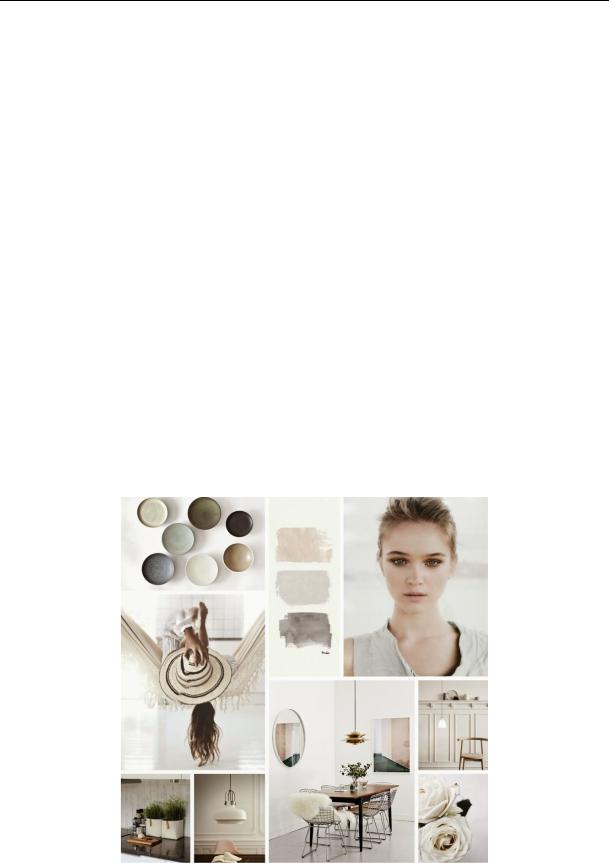
Russian Journal of Building Construction and Architecture
basic principles of distinguishing the internal structure as a consequence and manifestation of the inner world of man for centuries have been embodied to varying extent of dissimilarity in private housing. This was not only the matter of the customer’s taste, but also in many ways by the artist’s or, in other words, the performer’s signature style.The unification of efforts paved the way for the individuality of space [5, 6].
As the digital age came around, the individual approach was rapidly giving in. This happened in several directions: the actual interior design has become unified at the level of technology. Software is much more efficient than manual drawing. The selection and variability of space filling from the individual has transformed into a parade of large manufacturers, and the architect/artist/designer’s task was mainly to compile available ready-made items, simply put, to assemble puzzles. And the devil, as always, is in the details: a huge number of items on offer cannot be seen, touched, felt as these are all digital catalogues and small samples. The process of designing the environment has boiled down to flipping through pictures and composing collages, the so-called mood board –– it is difficult to imagine anything less useless than that. But everything has gone digital, swiftly changing and thus completely barren of the value of an integral image (Fig. 1).
Fig. 1. Example of a mood board (the photo is taken from the Internet)
98
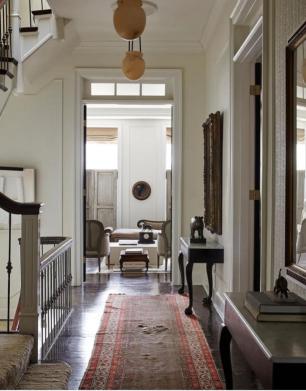
Issue № 2 (50), 2021 |
ISSN 2542-0526 |
The formation of the terms of reference for the design has experienced dramatic changes, the time of trends and Pinterest calls for complete unification under the illusion of individualization. What took time, ability to see and talent, has now occupied the gap between a coffee being drunk and a dessert being eaten. The image seen on the Net, not related to the available space, dominates the choice of design solutions. And this is not a mundate attitude «I want to be like Vasya», no, this is an obsessive idea of conformity to a certain category, status, even political views. Supporting inner conviction by means of packaging, even color, not just the architecture of the space, is changing. All of this is due to inseparable ties with thematic publications, new didgital media from architecture and art, imposing their own, from their point of view exceptionally correct understanding of space.
Here is a simple example: America's top 100 interior designers [9]. A photo with a rug with a hole causes a great deal of admiration and awe (Fig. 2).
Fig. 2. Image of the interior with the rug [9]. Author — Darryl Carter
The question is why does it? Because it is not a photo of the interior and a testament to the talent of the designer, it is a manifesto of a way of life conveyed through the stylization of space. No customer who has paid for an interior design project will live with a carpet with
99
